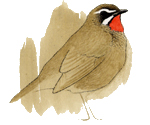Dutch birding bird names
(latest update: 22 January 2016)
(See also special issue Dutch Birdings' bird names)
This list contains all species recorded up to 15 January 2016 in Europe with Macaronesia, all countries bordering the Black or Mediterranean Sea, the Arabian Peninsula (sensu lato) and Iran. Since borders of countries are followed, this area does not precisely overlap the Western Palearctic (WP) region as defined by, eg, Martins & Hirschfeld in Sandgrouse (1998) which, for instance, includes the north of Mauritania, Mali, Niger and Chad but excludes south-western Arabia. (Species only recorded in Yemen and/or the Asir region, Saudi Arabia, are marked by **; and those recorded only in Iran are marked purple (cf Podoces 1-4, 2006-09)). The Asian part of Kazakhstan and Socotra are not included for this list.
The Dutch, English and scientific (sub)species names follow the 'rules' set by the Dutch Birding journal and the Dutch committee for avian systematics (CSNA) and are used by, eg, Dutch Birding Association and The Sound Approach.
English vernacular names are those recommended in Birds of the world: recommended English names by Gill & Wright (2006) and Gill & Donsker (2012). The Dutch names are based upon Vogels van de wereld: complete checklist by Walters (1997) and updated in Gill & Donsker (2012).
The sequence of passerines follows Sangster et al in Ibis 152: 180-186, 2010 and that of grouse and waders Sangster et al in Ibis 154: 874-883, 2012. The order in which families of non-passerines are listed (and most taxa in these families) follows Cracraft's contribution to The Howard and Moore complete checklist of the birds of the world, fourth edition, volume 1, by E C Dickinson & J V Remsen (editors) (2013).
The list includes a few species which were not accepted in any country other than in 'category D or E', indicating concerns about their provenance (Cape Shoveler in Morocco, Chinese Pond Heron in England, Finland, Hungary and Norway, White-backed Vulture in Portugal and Spain, and Swainson's Hawk in France and Norway) and two which have not (yet) been accepted by the relevant rarities committee (Eastern Yellow Wagtail in England and Blue Grosbeak in Azores and Norway). 'Category D' is not applied by rarities committees in the Netherlands and therefore not in this list either.
The list also includes seven taxa which have gone extinct in the world since 1840 (Canary Islands Oystercatcher, Eskimo Curlew, Slender-billed Curlew, Great Auk, Cape Verde Kite, Lanzarote Chiffchaff and Egyptian Sardinian Warbler).
A number of distinct subspecies are listed as well. These concern taxa which sometimes have been considered specifically distinct. When subspecies are mentioned, the commonest European taxon is not repeated when that also happens to be the nominate (with the exception of a few confusion cases).
Unnamed taxa are not listed (eg, Gray-bellied Brant, Arabian Helmeted Guineafowl, Grant's Storm Petrel and crossbill 'vocal types' A Wandering, B Bohemian, C Glip, D Phantom, E British, F Scarce and X Parakeet Crossbill).
Species for which it is certain that not a single individual arrived or occurred by its own force as a wild bird are excluded. Introduced species with viable breeding populations of which all individuals or their ancestors certainly originate from captivity are listed separately at the bottom (excluding those which have gone extinct).
Recent changes are highlighted in blue or, when dating from 2013-14, in red (cf van den Berg, A B 2008. Dutch Birding-vogelnamen: lijst van West-Palearctische vogelsoorten 2008. Amsterdam. ISBN 978-90-808433-4-9.)
°(Sub)species recorded in the Netherlands are indicated by an open circle behind the Dutch name.
1) Introduced Dutch species indicated by 1) are not officially part of the Dutch list. Four of these (Egyptian Goose, Common Pheasant, Sacred Ibis and Common Pigeon) are in the main list because they occur or have occurred in recent times in genuinely wild populations elsewhere in the region; Canada Goose is on the Dutch list because the occurrence of wild individuals cannot be excluded.
°2) For one taxon indicated by °2) related taxa could not be excluded with certainty (Fea's Petrel).
4) For one species indicated by 4) only a hybrid has been accepted (Azure Tit).
Arnoud B van den Berg © January 2016



